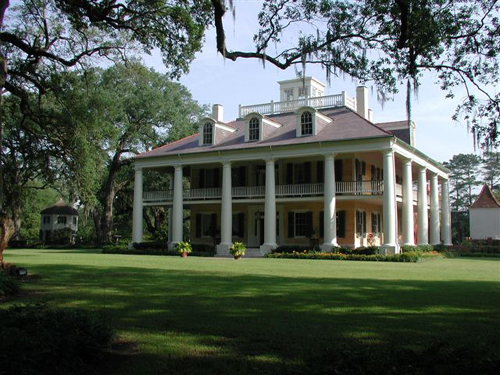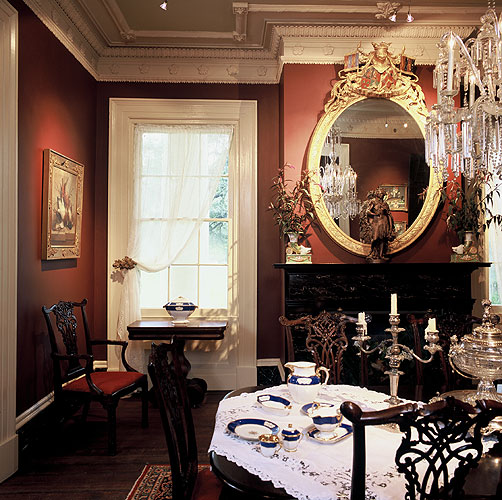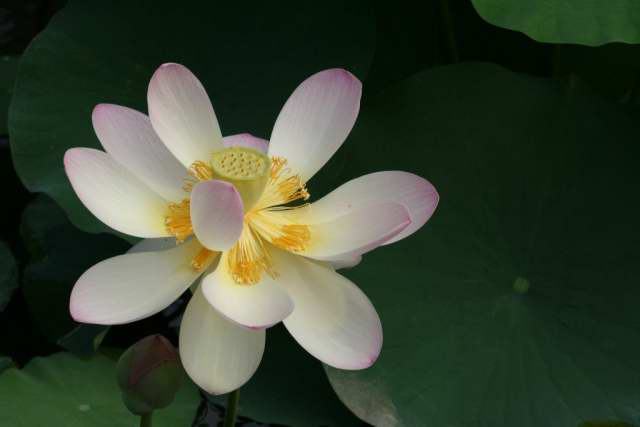Houmas House Plantation and Gardens has reclaimed its position as Crown Jewel of Louisiana’s River Road.
NOTE: All the information, photos and videos have been collected from the oficial web page of this historic and beautifull place www.houmashouse.com
Through the vision and determination of Kevin Kelly, who fulfilled a lifelong dream by acquiring the property in the Spring of 2003, the mansion today reflects the best parts of each period in its rich history alongside the big bend in the Mississippi River.
Whether you’re being guided through the mansion with its artwork, artifacts and antiques or discovering the beauty of the immaculate gardens and grounds, you will quickly understand that a visit to Houmas House Plantation and Gardens is a unique experience.

The first owners of the plantation were the indigenous Houmas Indians, who were given a land grant to occupy the fertile plain between the Mississippi and Lake Maurepas to the north.
The Houmas sold the land to Maurice Conway and Alexander Latil in the mid 1700’s The original French Provincial house that Latil erected on the property in is situated directly behind the Mansion, adjoined by a carriageway to the grand home described during its antebellum heyday as «The Sugar Palace.» The original home was later used as living quarters for the staff that served the great house.

By the time of the Louisiana Purchase in 1803, the plantation was established and producing sugar. In 1810, Revolutionary War hero Gen. Wade Hampton of Virginia purchased the property and shortly thereafter began construction on the Mansion. However, it was not until 1825 when Hampton’s daughter, Caroline, and her husband, Col. John Preston, took over the property that the grand house truly began to take shape.
Construction on the Mansion was completed in 1828. At the same time, Houmas House began to build its sugar production and continued to increase its land holdings, which ultimately grew to 300,000 acres.
Irishman John Burnside bought the plantation in 1857 for $1 million. A businessman and a character, Burnside increased production of sugar until Houmas House was the largest producer in the country, actively working the crop on 98,000 acres. During the Civil War, Burnside saved the Mansion from destruction at the hands of advancing Union forces by declaring immunity as a subject of the British Crown. In addition to building a railway to carry his products to market —«The Sugar Cane Train (1862)» — Burnside, a bachelor, is also said to have offered payment to any parents in the parish who would name their sons «John.»

An avid sportsman who wagered heavily in horse races, Burnside once secretly purchased a champion thoroughbred back East with the intent of defeating the steeds of fellow local businessmen in a big race. He quietly slipped the racehorse into the billiard room of the Mansion where it was «stabled» until Burnside’s surprise was unveiled at the starting line and hailed in the winner’s circle.
Houmas House flourished under Burnside’s ownership, but it was under a successor, Col. William Porcher Miles that the plantation grew to its apex in the late 1800’s when it was producing a monumental 20 million pounds of sugar each year.
In 1927, the Mississippi came out of its banks in the epic «great flood.» While Houmas House was spared, the surrounding areas were inundated. The ensuing economic havoc was but a prelude to the devastation of the Great Depression just two years later.

Houmas House Plantation withered away. The Mansion closed and fell into disrepair, a condition in which it remained until 1940 when Dr. George B. Crozat purchased it.
Crozat bought Houmas House to be a summer home away from his native New Orleans. He renovated the property with the intent to give it a more «Federal» look than the stately Greek Revival style in which it was conceived. The structure was painted white inside and out. Crown moldings and ceiling medallions were removed and both interior and exterior forms and finishes were simplified.
Eventually, the Crozat heirs opened the property to tourists. In 1963, the defining Bette Davis film «Hush, Hush Sweet Charlotte» was shot in the property. The room in which Ms. Davis stayed while filming is preserved as part of today’s Houmas House tour.
In addition to the Mansion and Gardens, history is also reflected in the many antique furnishings and works of art that grace the Houmas House tour. Distinguished by its two Garconierre, the Mansion exudes the warmth of a home (it’s the owner’s active residence), while proudly portraying its role as a landmark in American history.
ARCHITECTURE
Many different architectural styles can be found among the plantation homes along Louisiana’s Great River Road and throughout the south. Wherever wealth, social status and heartfelt hospitality converged, these antebellum structures — some more grand than others — rose to reflect these and other characteristics of the landowners.

Some of the main houses were simple home places designed as raised Creole cottages made largely from native Cypress and built for comfort and practicality.
Others took the form of grand mansions; some expressed in styles of Greek Revival, Italianate, Federal or other architectural styles. To a great extent, the point of these elegant and dramatic southern mansions was to emulate the grand homes and villas of wealthy Europeans who set the standard of the day for exhibiting wealth and expressing style.
Upon its completion in 1840, Houmas House was the Crown Jewel of Louisiana’s River Road with its heroically-columned Greek Revival exterior topped by a belvedere that surveyed the Oak alley leading south to the sweeping bend in the Mississippi and the miles and miles of cane fields to the north and east.
But that 1840 mansion with its broad galleries and thick masonry walls had humble beginnings in the mid-1700’s when the original house was built on the site by Maurice Conway and Alexandre Latil, New Orleans businessmen who purchased the property from the Houmas Indians. Latil designed a more modest home that reflected both the French and Spanish architectural influences that still define Louisiana’s heritage. The smaller residence that also houses the kitchen and is now connected at the back of the Mansion by a carriageway was, indeed, the original Latil House.

After Gen. Wade Hampton of South Carolina bought the property in 1810, his son-in-law Col. John Preston and daughter Caroline began construction on the present Mansion. As was often the practice in those days, the great house grew in stages and reached its final full dimension in 1840.
The Mansion is an excellent example of the peripteral type of Greek Revival architecture in which the main structure is surrounded by grand columns, each with an uninterrupted span from ground level to the roofline.
Among Houmas House Plantation and Gardens’ unique features are twin Garconierre, very rare among plantation homes. Federal arched dormers stand above the large Doric galleries.
Nearly 100 years after the Mansion was completed, Dr. George Crozat purchased Houmas House as his country escape from his city place in New Orleans. Determined to «Federalize» the look of the home, Dr. Crozat removed ornate features such as cornices, crown moldings and ceiling medallions and painted the structure white, both inside and out. During this time, modern plumbing was added and several changes were made to the service quarters, including the addition of an upstairs hallway to connect the two structures and the installation of a striking Palladian window that provides a view of the fountain courtyard.

When New Orleans businessman and preservationist Kevin Kelly fulfilled a lifelong dream by purchasing the home in early summer, 2003, he set about recreating the experience of encountering Houmas House circa 1840.
Today, visitors to Houmas house encounter Kelly’s loving salute to the grand property’s antebellum heritage his respectful homage to his antebellum predecessors.
The mansion’s faux marble exterior is painted in rich ochre which reflects the influence of Mediterranean villas owned by the wealthy Europeans that the southern planters emulated. The belvedere that crowns the house has been restored, and interior features and finishes have been reinstalled in their original form. The twin Garconierre that distinguish the property have been renovated, and the central hallway of the grand house bears a room-size mural with a sugar cane motif that characterizes the original entryway artwork common in many plantation homes along the Mississippi.

GARDENS
The Gardens of Houmas House Plantation have been developed as a lush 38-acre panorama of indigenous Louisiana plant life and stunning exotics designed to beckon visitors to extend their stay.
Like the statues of the four seasons patiently await the arrival of each solstice and equinox along the River Road, the Gardens are planned to reflect the unique beauty of each part of the year.
Many sitting areas have been provided around the property to invite guests to sit and experience the year-round grandeur of the ancient oak alley, the fragrance of spring and summer blooms and the sights and sounds of bird life, wildlife and plantation life of long ago..

The Hampton Garden, the Upper Garden and the Neptune Pavillion Fountain and Lawn flank the dramatic and inviting Fountain Courtyard where many guests like to congregate following their tour of the Mansión
MOVIES FILMED
Houmas House Plantation and Gardens has been a member of the supporting cast in a variety of motion pictures, made-for-television movies, TV series episodes, Soap Opera location shoots, television commercials and a variety of other projects that required consummate plantation visuals.
From Bette Davis to Cicely Tyson, Chevy Chase, James Franciscus, Susan Lucci, and others, Houmas House has complimented the work of stars.
With the property restored to its antebellum glory, Houmas House Plantation and Gardens is once again available as a preferred location for film and video projects.
 |
|
still from Hush, Hush Sweet Charlotte (1964)
|
A brief on-screen history of Houmas House:
- Hush, Hush Sweet Charlotte, 1964
- Longstreet TV Series, 1971-72
- Moon of the Wolf, 1972
- Mandingo, 1975
- A Closer Walk, 1976
- Big Bob Johnson and his Fantastic Speed Circus, 1978
- A Woman Called Moses, 1979
- All My Children, 1981
- Fletch Lives (Fletch II), 1988
- Snow Wonder (Hallmark Hall of Fame), 2006
- K’ville (Fox TV series, pilot and first episode), 2007
- Top Chef, 2009
,
- Revenge of the Bridesmaids, 2010
- Love, Marriage, Wedding, 2010
- Wheel of Fortune, 2011
,
The Mansion and grounds have also been seen in commercials for Budweiser, Virginia Slims, Best Buy, Hibernia Bank and the State of Louisiana (tourism).



